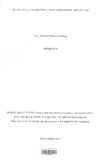| dc.description.abstract | The Economic environment in the world is changing rapidly. The change is characterised by such phenomena as. changing customer and investor demands, increasing product-market competition and globalization. To compete successfully in this environment, organizations need to continually improve their performance. In this regard, strategic resource management has been viewed as a strategy towards enhancing performance in order to acquire competitiveness, ( arliskan (2010). Organizational performance is concerned with establishing congruency between organisational goals and societal aspirations through input-output relationships. Further, performance is the culminating result of interactions of the organisational management systems with both the internal and external environmental factors. In the recent past, an extraordinarily predominant socio-economic-political phenomenon has changed the structural configuration of the business world, and operational paradigms of the manufacturing industries. Historically, financial performance indicators, such as return on investment, return on assets, operating profit margin, profit after tax. earning per share, among others, have been used to determine the performance of organizations. It is with this regard that productivity is gaining ground as an indicator of organizational performance. It is important to note that productivity is affected by both internal and external factors. Culture within an organization is one of the internal factors that may affect productivity. K'Obonyo and Dimba (2009) indeed acknowledged in their research that culture is a very potent factor which affects strategic resource management and productivity. The cultural context in which an organization operates will thus have an effect on the strategic resources that are available and how they can bring optimal utility to the organization. The resource-based view is a way of viewing performance of a firm and in turn of approaching strategy. Prahalad and Hamel (1990) viewed and conceptualized the firm as a bundle of resources. These resources, and the way they are combined, are what differentiates one firm from another. While it might seem somewhat obvious that firms are different because they tire comprised of different resources, this perspective is a significant departure from the long dominant market based view held by Porter. Firm resources are generally quite loosely defined, tending to include everything internal to the firm. Barney (1986) lists all assets, capabilities, organizational processes, firm attributes, information, knowledge, among others, as resources. ^>o. it resources can be anything internal to the firm, it is prudent to determine the ones which are
vi
more strategically important and use them to gain competitive advantage. Barney (1991) has put forward a popular checklist to help in determining the resources that are strategic to an organization. Within a firm, there are tangible strategic resources which are mainly human capital and physical capital, and intangible strategic resources which include the firm's organizational capital. Markets change, however, so this means that the resources of an organization also need to change over time to remain relevant in the marketplace. This gives rise to the need for knowledge of the market, which would lead to implementing strategies that would gi\e an organization the competitive edge. The resource based view of strategy will be used to discuss Strategic management and the performance of organizations in the following sections of this paper. This paper will lead to a study that will address the gap in the literature which will answer the question: do organizations realize the potential of the strategic resources that they own when developing strategy and how does this knowledge impact on sustained competitive advantage and organizational performance? | en_US |

